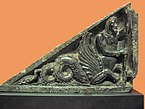Stair riser
This article does not cite any sources. (February 2007) |

A stair riser is the near-vertical element in a set of stairs, forming the space between one step and the next. It is sometimes slightly inclined from the vertical so that its top is closer than its base to the person climbing the stairs. The horizontal edge of the stair is called the nosing, whereas the surface on which a person's whole foot makes contact is called the tread.
Gandharan stair risers[]
Decorated stair risers were used extensively in the Greco-Buddhist art of Gandhara, to form the pedestal to small devotional stupas. They were usually adorned with friezes, fantastic animals and decorations.
A flight of stairs with decorated stair risers from the Chakhil-i-Ghoundi Stupa has been almost fully restored and can now be seen at the Guimet Museum in Paris.
Archaeological research by the Italian IsMEO at the Butkara Stupa suggests that small decorative stairs were adjoined to Buddhist stupas at the time of the Indo-Greek Kingdom, and that they were decorated with Buddhist scenes.

A reconstituted flight of stairs with stair risers, from the Chakhil-i-Ghoundi Stupa.
A Gandharan Buner relief of a stair riser with devotees (1st-2nd century CE), Victoria and Albert Museum collection.

A side stair riser depicting an Ichthyo-Centaur, also considered as a Buner relief.
External links[]
| Wikimedia Commons has media related to |
- Stairs
- Stairways
- Architectural elements
- Architectural element stubs


